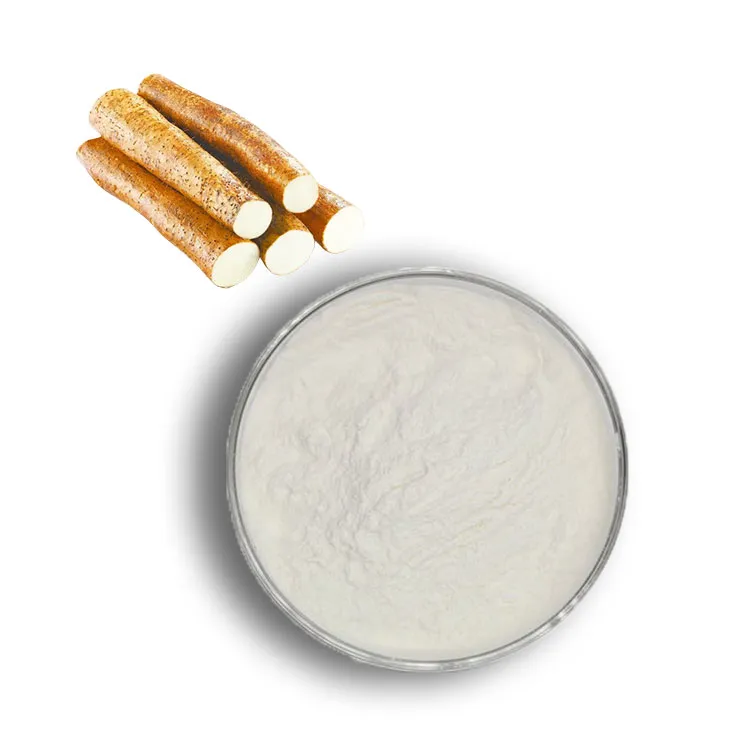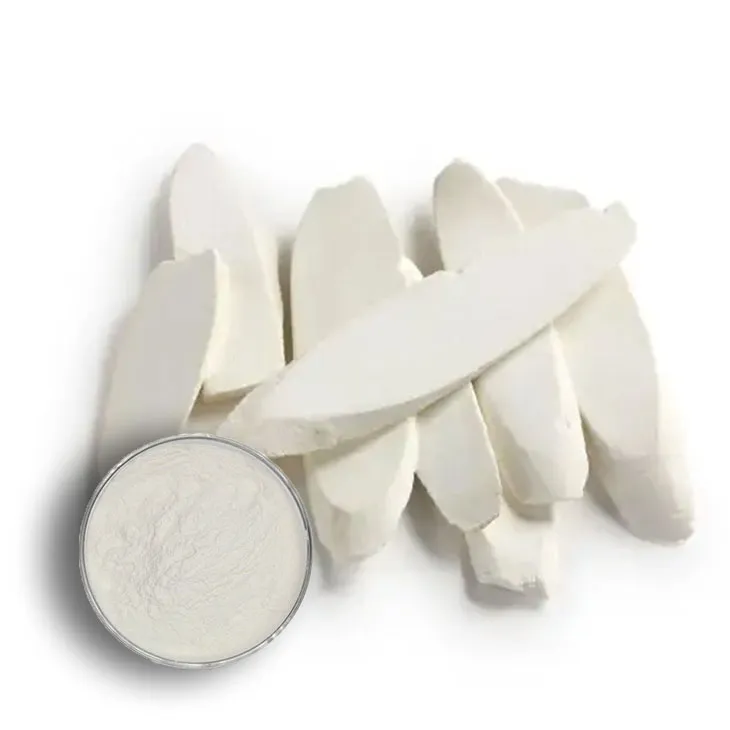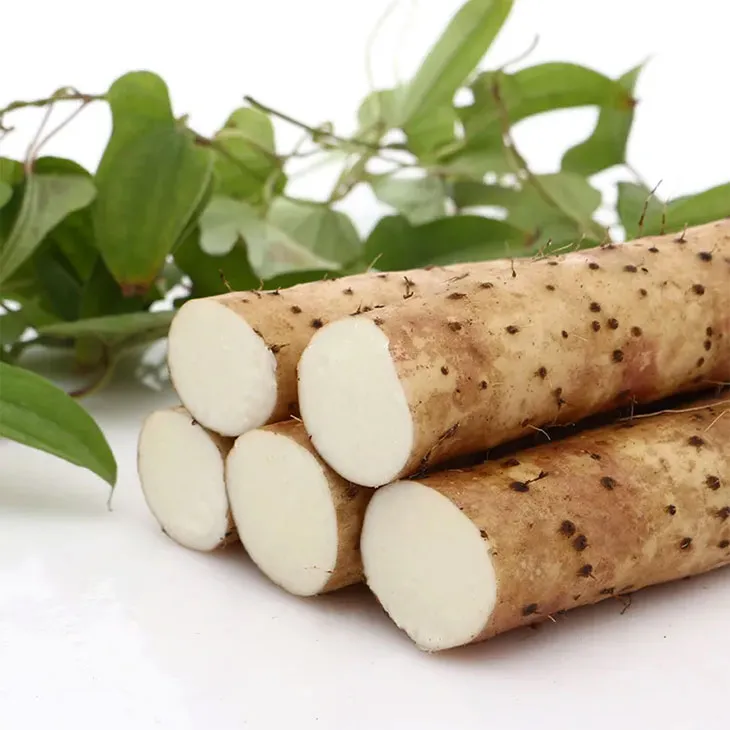- 0086-571-85302990
- sales@greenskybio.com
Components of Yam Extract in Fertilizers and Feeds.
2024-11-28

1. Introduction to Yam Extract
Yam is a plant with significant potential in various industries, especially in the fields of fertilizers and feeds. Yam Extract, which is obtained from different parts of the yam plant, contains a rich variety of substances that can be harnessed for different purposes. The yam plant is known for its adaptability to different environmental conditions, and this resilience is often reflected in the properties of its extract.

2. Yam Extract in Fertilizers
2.1 Nutrient Content in Yam Extract for Fertilizers
Yam extract contains several important nutrients that are beneficial for soil fertility. For example, it has a certain amount of nitrogen, which is a key element for plant growth. Nitrogen is essential for the formation of chlorophyll, the pigment that enables plants to carry out photosynthesis. Without sufficient nitrogen, plants may exhibit stunted growth and yellowing of leaves.
Additionally, yam extract also contains phosphorus and potassium. Phosphorus is crucial for root development, flowering, and fruiting in plants. It is involved in energy transfer processes within the plant cells. Potassium, on the other hand, helps in regulating plant water uptake, improving the plant's resistance to drought and diseases.
2.2 Organic Compounds in Yam Extract for Fertilizer
One of the significant organic compounds present in yam extract is polysaccharides. These complex carbohydrates can have a positive impact on soil structure. They can help in binding soil particles together, creating a more stable soil aggregate. This, in turn, improves soil aeration and water - holding capacity.
Another important group of organic compounds are phenolic compounds. These compounds can have allelopathic effects, which means they can influence the growth and development of other plants or organisms in the soil. In some cases, phenolic compounds can inhibit the growth of harmful weeds or pathogens in the soil, providing a more favorable environment for the growth of desired crops.
2.3 Role of Yam Extract in Boosting Soil Microorganisms
The components in yam extract can serve as a food source for soil microorganisms. Soil bacteria and fungi are able to break down the organic matter in the yam extract and utilize the nutrients present. For example, some bacteria can decompose the polysaccharides in the yam extract and release simpler sugars, which they can then use for their own growth and reproduction.
When soil microorganisms are active, they play a vital role in nutrient cycling. They can convert nutrients from an unavailable form to an available form for plants. For instance, certain bacteria can fix atmospheric nitrogen into a form that plants can absorb. Fungi can also form symbiotic relationships with plant roots, known as mycorrhizae, which help in enhancing the plant's ability to take up phosphorus and other nutrients from the soil.

3. Yam Extract in Feeds
3.1 Nutritional Value of Yam Extract for Feeds
Yam extract contains valuable nutrients for animals. It is a source of protein, which is essential for muscle development, growth, and repair in animals. Protein is made up of amino acids, and yam extract can provide some of the essential amino acids that animals cannot synthesize on their own.
In addition to protein, yam extract also contains vitamins such as vitamin C and some of the B - vitamins. Vitamin C is important for the immune system of animals, helping them to resist diseases. B - vitamins play a role in various metabolic processes, including energy metabolism and nerve function.
3.2 Bioactive Substances in Yam Extract for Feeds
There are several bioactive substances in yam extract that can benefit animal health. Saponins, for example, are compounds that can have anti - parasitic properties. They can help in reducing the infestation of internal parasites in animals, which can improve the overall health and productivity of livestock.
Another group of bioactive substances are flavonoids. Flavonoids have antioxidant properties, which means they can protect the cells of animals from damage caused by free radicals. Free radicals are highly reactive molecules that can cause oxidative stress in animals, leading to various health problems such as reduced fertility and weakened immune systems.
3.3 Impact of Yam Extract on Animal Digestion and Absorption
The bioactive substances in yam extract can enhance the digestion and absorption of nutrients in animals. For example, saponins can act as surfactants, which can help in breaking down fats and improving their absorption in the intestines. This can lead to better utilization of dietary fats, which are an important source of energy for animals.
Yam extract can also have a positive impact on the gut microbiota of animals. The gut microbiota plays a crucial role in digestion and nutrient absorption. The substances in yam extract can promote the growth of beneficial bacteria in the gut, such as lactobacilli and bifidobacteria. These bacteria can help in fermenting dietary fiber and producing short - chain fatty acids, which are beneficial for the health of the gut and can also be absorbed by the animal as an energy source.

4. Extraction and Processing of Yam Extract
4.1 Extraction Methods
There are several methods for extracting yam extract. One common method is solvent extraction. In this method, a suitable solvent such as ethanol or water is used to extract the desired components from the yam. Ethanol is often preferred for extracting lipophilic compounds, while water can be used for extracting hydrophilic substances.
Another method is mechanical extraction, which involves grinding the yam and then separating the extract using techniques such as filtration or centrifugation. This method is relatively simple and can be used for obtaining crude extracts.
4.2 Processing and Purification
After extraction, the yam extract may need to be processed further to remove impurities and concentrate the desired components. Filtration can be used to remove solid particles from the extract. Evaporation or drying techniques can be employed to reduce the volume of the extract and obtain a more concentrated product.
For more purified extracts, techniques such as chromatography can be used. Chromatography can separate different components based on their physical and chemical properties, allowing for the isolation of specific bioactive substances from the yam extract.

5. Safety and Quality Considerations
5.1 Quality Control of Yam Extract
Quality control is essential when dealing with yam extract for fertilizers and feeds. The extract should be analyzed for its nutrient content, bioactive substances, and potential contaminants. Analytical techniques such as spectroscopy and chromatography can be used to determine the composition of the extract accurately.
It is also important to ensure that the yam used for extraction is of high quality. Yam plants should be grown under proper agricultural practices, free from excessive pesticide and fertilizer use, to avoid contaminating the extract.
5.2 Safety Aspects of Yam Extract in Feeds
While yam extract has many benefits in feeds, safety aspects need to be considered. Some bioactive substances in yam extract, such as saponins, may be toxic in high concentrations. Therefore, it is crucial to determine the appropriate dosage of yam extract in animal feeds to avoid any adverse effects on animal health.
Additionally, any potential allergens present in the yam extract should be identified and labeled properly, especially when used in feeds for livestock that may be used for human consumption, such as dairy cows or poultry.
6. Conclusion
Yam extract has great potential in both fertilizers and feeds. Its components can offer numerous benefits, from improving soil fertility and microorganism activity in fertilizers to enhancing animal health, digestion, and productivity in feeds. However, proper extraction, processing, quality control, and safety considerations are necessary to fully realize its potential in these applications. With further research and development, yam extract can play an even more significant role in sustainable agriculture and livestock production in the future.
FAQ:
What are the main components of yam extract in fertilizers?
The main components of yam extract in fertilizers often include various organic compounds. These can be carbohydrates, proteins, and other bioactive substances. Carbohydrates can serve as an energy source for soil microorganisms, promoting their growth and activity. Proteins may break down into amino acids, which are also important for soil microbial metabolism. Additionally, yam extract may contain trace elements and growth - promoting factors that enhance the overall function of the fertilizer.
How does yam extract in feed help animals digest better?
The yam extract in feed contains bioactive substances. Some of these substances can stimulate the production of digestive enzymes in animals' digestive systems. For example, certain compounds may increase the activity of amylase, protease, or lipase. These enzymes are crucial for breaking down carbohydrates, proteins, and fats respectively. Moreover, the bioactive substances may also improve the gut environment, such as by promoting the growth of beneficial gut bacteria, which in turn aids in the digestion and absorption of nutrients.
Can yam extract in fertilizer replace chemical fertilizers completely?
Yam extract in fertilizer cannot completely replace chemical fertilizers at present. While yam extract has many beneficial effects on soil microorganisms and nutrient cycling, chemical fertilizers are often more concentrated sources of essential nutrients like nitrogen, phosphorus, and potassium. However, yam extract can be used as a complementary component to chemical fertilizers. It can improve soil structure and microbial activity, which can enhance the efficiency of chemical fertilizers. In some organic farming systems, yam extract - based fertilizers can play a more significant role, but a complete replacement is not feasible in large - scale, high - intensity agricultural production.
What are the potential side effects of using yam extract in feed?
When used properly, yam extract in feed generally has few side effects. However, if over - used, it may cause some issues. For example, an excessive amount of certain bioactive substances in yam extract could potentially disrupt the normal balance of the animal's endocrine system. Also, if the yam extract is not properly processed and contains contaminants, it could lead to adverse effects on animal health. But with strict quality control during extraction and proper dosage in feed formulation, these potential problems can be minimized.
How is yam extract obtained for use in fertilizers and feeds?
Yam extract for fertilizers and feeds is typically obtained through extraction processes. First, the yams are harvested and cleaned. Then, they can be crushed or ground to increase the surface area for extraction. Solvents such as water or organic solvents may be used to extract the desired components from the yam. In some cases, enzymatic hydrolysis may also be involved to break down complex molecules into more useful forms. After extraction, the extract is usually purified and concentrated to obtain a product suitable for use in fertilizers or feeds.
Related literature
- Title: The Role of Yam Extract in Sustainable Agriculture"
- Title: "Bioactive Compounds in Yam Extract for Animal Nutrition"
- Title: "Yam Extract: A Natural Additive for Soil Fertility Enhancement"
- ▶ Hesperidin
- ▶ citrus bioflavonoids
- ▶ plant extract
- ▶ lycopene
- ▶ Diosmin
- ▶ Grape seed extract
- ▶ Sea buckthorn Juice Powder
- ▶ Beetroot powder
- ▶ Hops Extract
- ▶ Artichoke Extract
- ▶ Reishi mushroom extract
- ▶ Astaxanthin
- ▶ Green Tea Extract
- ▶ Curcumin Extract
- ▶ Horse Chestnut Extract
- ▶ Other Problems
- ▶ Boswellia Serrata Extract
- ▶ Resveratrol Extract
- ▶ Marigold Extract
- ▶ Grape Leaf Extract
- ▶ blog3
- ▶ blog4
-
Certified organic propolis extract powder.
2024-11-28
-
How to make powder with lemon extract.
2024-11-28
-
Certified organic aged garlic extract.
2024-11-28
-
Active components in yam extract.
2024-11-28
-
Pine bark Extract Powder
2024-11-28
-
Mangosteen extract powder
2024-11-28
-
Avocado Extract Powder
2024-11-28
-
Almond Extract Powder
2024-11-28
-
Chasteberry Extract
2024-11-28
-
Chaste Berry Extract
2024-11-28
-
Agaricus Blazei Extract
2024-11-28
-
Feverfew Extract
2024-11-28
-
Oyster Mushroom Extract Powder
2024-11-28
-
Red Vine Extract
2024-11-28





















